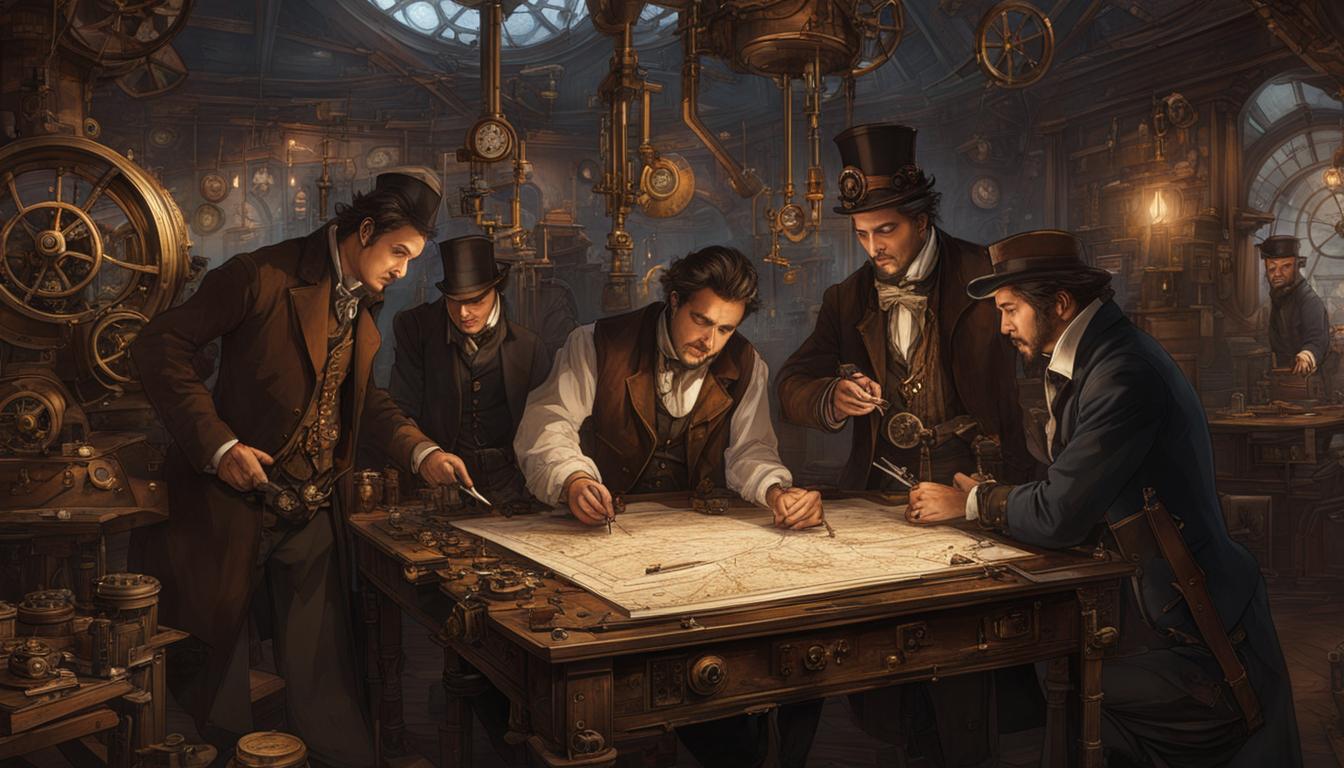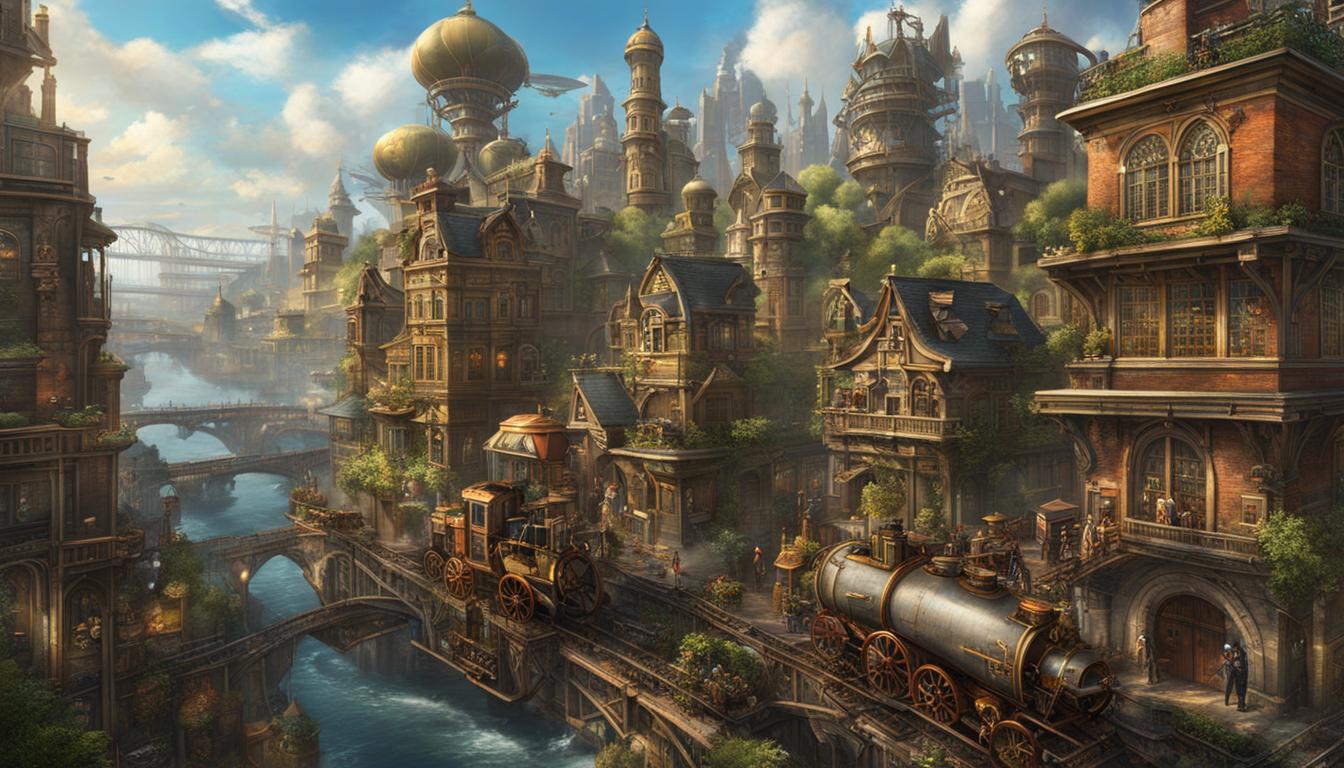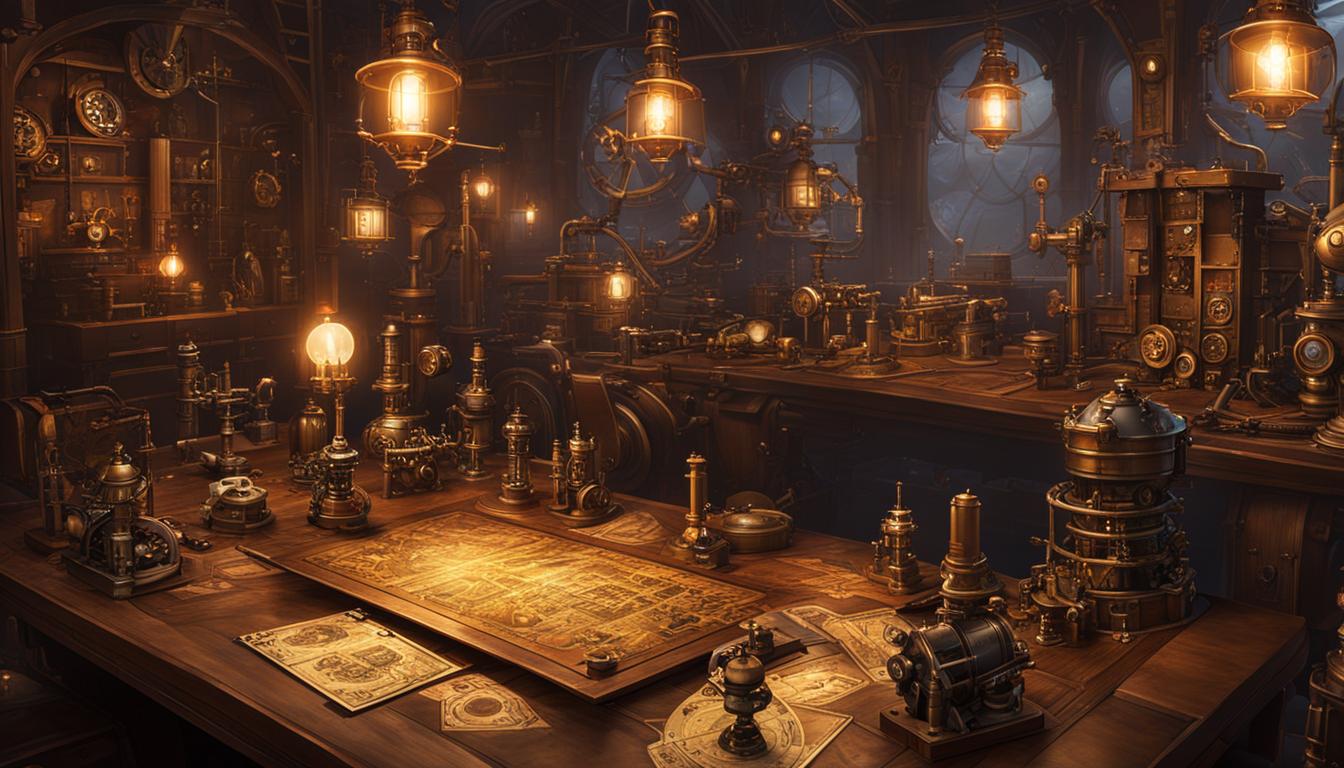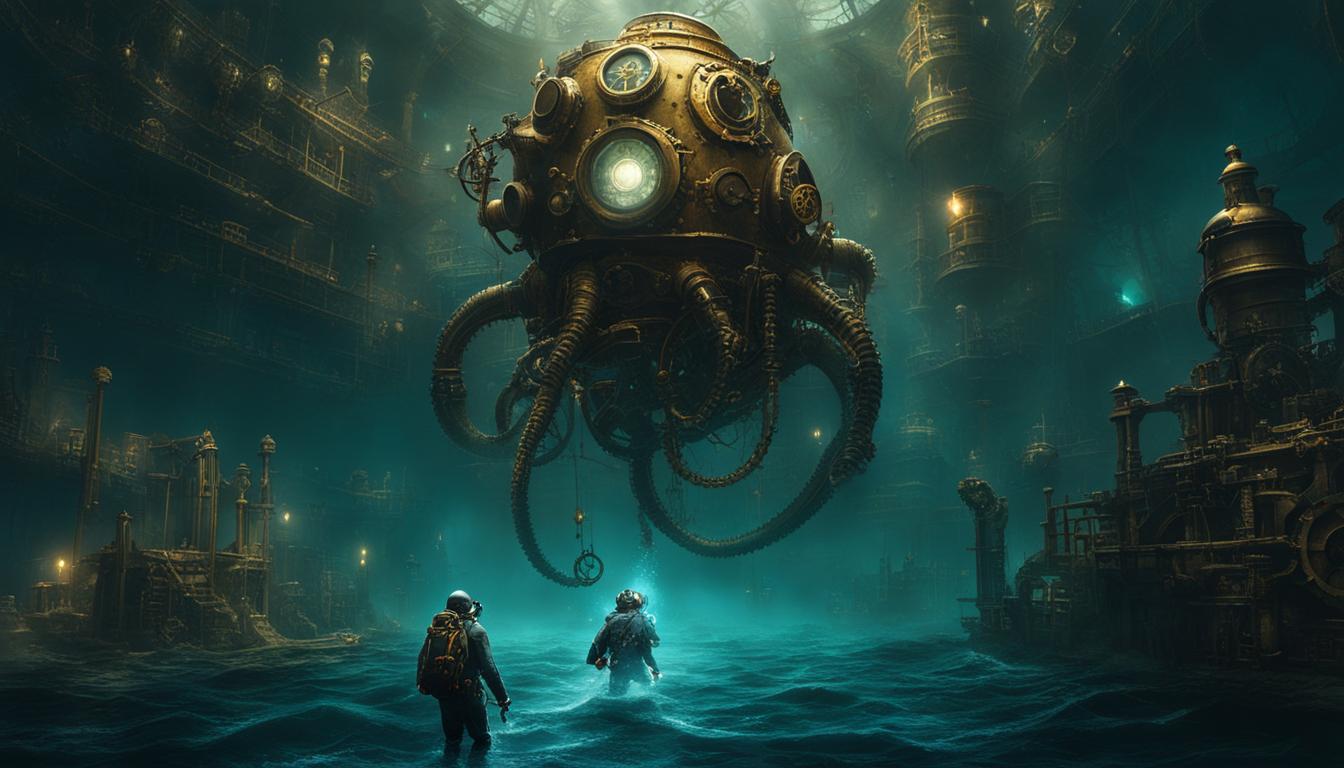Role-playing games (RPGs) have long captivated the imaginations of players, allowing them to embark on thrilling adventures in fantastical realms. The steampunk genre, with its fusion of Victorian aesthetics and steam-powered technology, offers a unique and captivating setting for immersive role-playing experiences.
In this section, we will explore various strategies and ideas for creating unforgettable steampunk RPG worlds. Whether you’re a game designer looking to craft a steampunk adventure or a player seeking tips on delving into the world of steampunk role-playing, this guide has got you covered.
Key Takeaways:
- Steampunk RPGs provide a blend of Victorian aesthetics and steam-powered technology.
- Creating immersive steampunk RPG experiences requires careful game design and world-building.
- Explore popular steampunk RPG titles and their unique mechanics.
- Crafting memorable characters and names adds depth to steampunk RPG campaigns.
- By following the strategies and ideas outlined, players and game designers can create unforgettable steampunk RPG experiences.
Exploring Steampunk RPG Titles and Mechanics
Steampunk role-playing games offer a captivating blend of Victorian aesthetics and steam-powered technology, providing players with a unique and immersive experience. In this section, we will dive into popular steampunk RPG titles and explore their distinctive mechanics that set them apart.
One standout example is Tephra: The Steampunk RPG, which introduces an innovative crafting system that allows players to combine different components and create unique inventions. This mechanic adds depth and strategic possibilities to the game, enabling players to customize their characters’ equipment and develop creative solutions to challenges.
Another remarkable title is Clockwork: Dominion, which focuses on social intrigue and political maneuvering within a steampunk world. The game mechanics emphasize dialogue, negotiation, and manipulation, providing players with a rich tapestry of opportunities to navigate complex relationships and shape the world around them.
“In the world of steampunk RPGs, the mechanics are often designed to reflect the themes and elements of the genre. Whether it’s crafting ingenious contraptions or engaging in political machinations, these mechanics enhance the immersive experience and allow players to truly embody the spirit of steampunk.”
When designing a steampunk RPG setting, it is essential to consider the unique aspects of the genre. The setting should evoke a sense of adventure, with fantastical technology and intricate societies. Players should feel transported to a world where steam-powered airships soar through the skies and clockwork automata roam the streets.
To create compelling steampunk adventures, game designers can draw inspiration from the works of Jules Verne, H.G. Wells, and other pioneers of the genre. Incorporating elements such as steam-powered gadgets, mysterious inventions, and sweeping vistas will add depth and excitement to the game world.
Table: A Comparison of Popular Steampunk RPG Titles and their Mechanics
| Steampunk RPG Title | Mechanics |
|---|---|
| Tephra: The Steampunk RPG | Innovative crafting system that allows players to create unique inventions |
| Clockwork: Dominion | Focus on social intrigue and political maneuvering within a steampunk world |
| Aether Captains | Naval combat and exploration set in a world dominated by airships and floating islands |
| Iron Kingdoms | War-focused gameplay with a rich blend of magic and technology |
The table above provides a glimpse into the diverse range of steampunk RPG titles and the mechanics that define them. Each game offers unique gameplay elements that cater to different preferences and play styles, ensuring that there is something for every steampunk enthusiast.
Crafting Memorable Steampunk RPG Characters and Names
One of the key aspects of a successful steampunk RPG is the creation of memorable characters. The steampunk genre is rich with possibilities for unique and intriguing character designs. When crafting characters for a steampunk RPG, it’s important to consider both their physical attributes and their personalities. Steampunk worlds often feature fantastical technologies and inventions, so characters can have mechanical limbs, steam-powered gadgets, or other enhancements that set them apart.
In addition to physical traits, their backstories and motivations should be thoughtfully developed to create depth and engagement. To immerse players in the steampunk world, it’s essential to consider how their characters fit into the setting and the narrative. Developing intriguing backstories that intertwine with the world-building elements of the game can enhance the overall immersion and offer players a sense of purpose within the game world.
When it comes to naming characters in the steampunk genre, it’s important to choose names that align with the setting and evoke a sense of the Victorian era. Names can be inspired by historical figures, technological terms, or even fictional elements. For example, a steampunk character might be named “Copperfield” to convey the industrial and mechanical elements of the genre. By carefully selecting names that reflect the steampunk aesthetic, characters become more authentic and memorable, adding to the immersive experience of the game.
Developing Steampunk RPG Campaigns
Creating a captivating steampunk RPG campaign requires careful planning and attention to detail. To provide an immersive and engaging experience for players, the campaign should incorporate elements of exploration, mystery, and adventure. Steampunk worlds are often vast and filled with hidden secrets, so designing quests and encounters that allow players to uncover these mysteries can keep them invested in the campaign.
When developing a steampunk RPG campaign, world-building is key. By crafting a detailed and believable steampunk world, players will feel more connected to the setting and the story. Paying attention to the intricate details of the world, such as the social hierarchy, technological advancements, and cultural nuances, can create a rich and immersive experience. Additionally, incorporating themes and conflicts that are relevant to the steampunk genre, such as struggles between tradition and progress or the impact of industrialization, can add depth and complexity to the campaign.
Overall, crafting memorable steampunk RPG characters and names, and developing immersive campaigns, is a delicate balance between creativity and attention to detail. By incorporating the unique elements of the steampunk genre and creating characters and campaigns that align with the setting, players can enjoy truly immersive and unforgettable role-playing experiences.
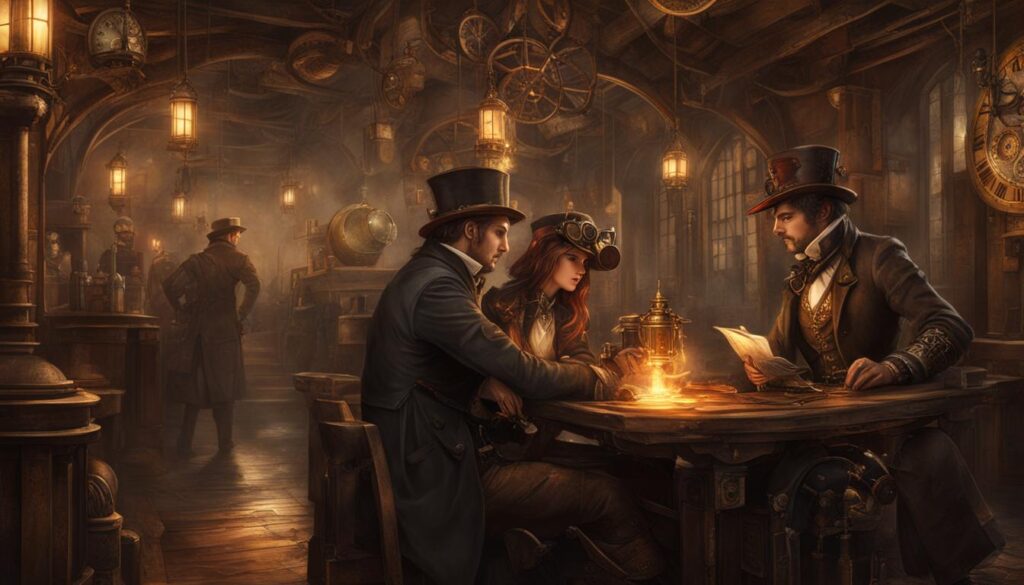
Conclusion
Steampunk role-playing and world-building offer a gateway to boundless creativity and imagination. By following the strategies and ideas outlined in this article, players and game designers alike can unlock the potential to create immersive and unforgettable steampunk RPG experiences. Whether it’s designing intricate steampunk settings, crafting thrilling adventures, or shaping memorable characters, the steampunk genre provides a rich and vibrant backdrop for storytelling.
With gears whirring and goggles donned, venture into the world of steampunk role-playing games and let your imagination soar. Picture a sprawling metropolis with towering steam-powered contraptions and airships gliding through the sky. Envision a cast of characters, each with their own gripping backstories and unique abilities. And behold the adventures that unfold, filled with danger, intrigue, and the pursuit of grand discoveries.
So, embrace the challenge of game design and world-building, and embark on a journey where the possibilities are limitless. Craft stories that transport players to a bygone era where technology meets Victorian elegance, and where the line between fantasy and reality blurs. Steampunk role-playing games await, beckoning you to unlock their secrets and create your own steampunk RPG worlds. It’s time to ignite your imagination and let the adventure begin!
FAQ
What is a steampunk role-playing game (RPG)?
A steampunk RPG is a type of role-playing game that takes place in a fictional world where steam-powered technology and Victorian aesthetics are prominent.
What are some popular steampunk RPG titles?
Some popular steampunk RPG titles include Tephra: The Steampunk RPG and Clockwork: Dominion, each offering unique mechanics and gameplay experiences.
How do I create a steampunk RPG setting?
Creating a steampunk RPG setting involves blending Victorian aesthetics with steam-powered technology, developing a rich and immersive world for players to explore.
How can I design compelling steampunk RPG adventures?
To design compelling steampunk RPG adventures, consider incorporating elements of social intrigue, epic quests, and exploration into your scenarios, providing players with engaging and immersive experiences.
What tips can you offer for crafting unique steampunk RPG characters?
When crafting steampunk RPG characters, consider choosing races and classes that fit the steampunk genre, and develop intriguing backstories that add depth and interest to your characters.
How do I create memorable names for my steampunk RPG characters?
When naming steampunk RPG characters, consider using names that reflect the Victorian era and the steampunk aesthetic, while still being unique and memorable.
How do I develop engaging steampunk RPG campaigns?
To develop engaging steampunk RPG campaigns, focus on creating immersive and interactive experiences for players, incorporating elements of mystery, exploration, and character development into your storytelling.
How can I bring steampunk worlds to life in my role-playing games?
To bring steampunk worlds to life in your role-playing games, let your creativity soar and your imagination run wild, incorporating intricate world-building, captivating storytelling, and immersive gameplay mechanics.

